The definitive guide to employee engagement surveys

Employees are the backbone of any business. And the more employees are engaged and committed they are, the better the impact on your company’s bottom line.
This is why employee engagement is an indicator of an organization’s health.
Richard Daft and Dorothy Marcic, Professor at Vanderbilt University and Professor at Columbia University respectively, said that employee engagement means “people enjoy their jobs and are satisfied with their work conditions, contribute enthusiastically to meeting the team and organizational goals, and feel a sense of belonging and commitment to the organization.”
A recent survey by Gallup found that in 2022, only 21% of employees feel engaged at work. Moreover, disengaged employees cost the world $7.8 trillion in lost productivity. When we consider the massive impact they have on the industry, every business must conduct an employee engagement survey to gauge the health of their business.
An employee engagement survey is a research-backed tool used to measure employees’ engagement at work. These surveys are online questionnaires that measure employee satisfaction, alignment, and overall organizational health.
They aim to improve employee retention, boost job performance and relationships with managers, and improve employee morale.
In this article, we’ll discuss the different types of employee surveys, questions, tools, and best practices you can implement in your next employee engagement survey.
Types of employee surveys
Employee surveys measure a specific goal (e.g., engagement, culture, onboarding) which is why there are many survey types available. Using a range of surveys—from regular polls to annual check-ins—companies glean valuable insights that help retain talent, improve employee morale, increase productivity, and reduce turnover.
Here’s a list of employee surveys you can integrate into your next feedback session:
Annual employee engagement survey
Employee engagement survey questions tap into how connected employees feel with their workplace. A compilation by Gallup found that while engagement peaked in 2020, there has been a downward trend post-2020. Meanwhile, disengagement continues to increase.
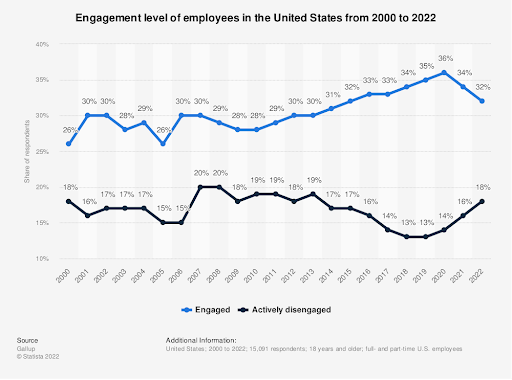
While 1:1 conversations work well to truly gauge how employees feel, factors like remote work, company size, and resource constraints can prevent these conversations from happening.
Using an annual employee engagement survey, you can conduct frequent check-ins with your employees. Most organizations tend to conduct annual surveys due to time or resource constraints, but only visiting these topics once a year might mean it’s too late to act on certain issues, as a lot can happen in a year.
Instead, we recommend conducting frequent pulse surveys to measure engagement over a period and conducting in-depth surveys at the end of the year.
Here are a few ways frequent employee engagement surveys can benefit your business:
- Employees have a safe space to voice their concerns
- Operations teams receive actionable feedback
- Human resources teams get ideas for engagement activities
- Business leadership gets insights on areas for improvement
Employee lifecycle survey
Employee lifecycle surveys allow you to collect data from employees at every stage of their relationship with your company. Right from the early days of onboarding through retirement, you can understand what their experience is like.
This survey allows you to find areas for improvement in the entire lifecycle and offers insights into why future hires should join your company.
Employee culture survey
Employee culture surveys give your company data about what employees think about their company culture and the workplace.
These surveys identify any problems and ensure they’re not being swept under the rug or worsening over time. They include aspects like peer relationships, organizational practices, and opinions on company leadership.
Employee opinion and satisfaction survey
Employee opinion and satisfaction surveys (also known as climate surveys) measure employee engagement levels, satisfaction, and attitude.
The idea is to gauge whether your employees experience the core beliefs your organization stands on. For example, if your core values reflect an independent and fast-paced culture, but the survey reveals employees feel differently, there’s room for improvement.
Employee performance survey
Employee performance surveys (or 360 surveys) gather feedback from different perspectives including team leaders, managers, peers, and self-evaluation.
While an employee might be able to tell you what they do well, they might overlook certain aspects of their work that they could improve. With an employee performance survey, you get a comprehensive overview of each employee’s performance—and can then translate them into actionable feedback.
8 employee engagement themes to consider for your next survey
A well-designed engagement survey will give you a clear understanding of your employees’ attitudes and perceptions. This offers a better understanding of their motivation and behavior.
According to Bill Catlette, Executive Coach, you need to keep these factors in mind before designing the survey:
- Satisfaction with leadership
- Satisfaction with the terms of the deal
- Susceptibility to unionization
- Perception of how well customers are being treated
- Clarity of direction and guidance
Depending on your company goals, you need to ask the right questions under several themes to create a balanced survey. Here’s a list we’ve compiled for you based on eight expert-recommended themes:
Theme #1: Satisfaction
Goal: To understand how well your organization creates a great place to work.
Why it’s important: Employees who are satisfied with the company culture, work environment, and responsibilities are less likely to leave the organization.
What to measure: If all employees feel valued, happy, and challenged.
Questions:
- How do you feel about your role and workload today?
- How likely are you to recommend [organization] to your friends and family?
- Do you look forward to coming to work every morning?
- Do you plan on working for [organization] for the next two years?
- Do you feel motivated and empowered in your current role?
- Do you feel satisfied working with your current team?
- Do you feel a sense of pride while working for [organization]?
- Are you happy with your current compensation package?
- Do you feel like your compensation matches your current responsibilities?
Theme #2: Alignment
Goal: To understand whether employees are aligned with the company’s mission, vision, and values.
Why it’s important: 70% of employees consider lack of alignment to be the greatest hurdle to achieving company strategy. Resolving this challenge can impact the company’s bottom line.
What to measure: If employees understand their responsibilities and if they feel like they’re making an impact.
Questions:
- Do you feel aligned with the company’s current vision?
- Are you clear about your current responsibilities?
- Do you find your current responsibilities meaningful?
- Do you feel recognized when you do good work?
- Do you feel that quality and improvement are prioritized regularly?
Theme #3: Leadership
Goal: To understand how well current leadership performs and communicates with employees.
Why it’s important: 52% of employees say that managers or companies could have done something to prevent them from quitting. If leaders focus on communicating with their employees, they can avoid this.
What to measure: If employees feel positively about their managers and company leadership.
Questions:
- Do you feel that your managers keep you informed on company objectives?
- Do you feel that your manager cares about your well-being?
- Do you agree with the approaches your managers take regularly?
- Is your manager an excellent role model for your team members?
- Does company leadership contribute to a positive work culture?
- Do you believe and have faith in [organization]’s leaders?
Theme #4: Job enablement
Goal: To analyze the efficiency of current processes and the availability of resources.
Why it’s important: When employees have the right resources to get the job done, it results in high-quality output, increased productivity, and company profitability.
What to measure: If employees have access to the right resources.
Questions:
- Have you been provided the right resources to do your job well?
- Is there room for improvement in the current processes?
- Are there enough learning and development resources available?
Theme #5: Career development
Goal: To understand if your organization is perceived as a source for professional development.
Why it’s important: 35% of employees surveyed said they left their employer for better career trajectories. Ensuring that such opportunities exist within the company increases retention.
What to measure: If employees feel they can progress within the company and have the necessary support.
Questions:
- Do you feel like your manager has a genuine interest in your career goals?
- Do you feel like there are good career opportunities in the company?
- Do you feel like you could potentially progress within the company?
- Does your manager help you succeed in your role?
Theme #6: Autonomy and empowerment
Goal: To understand how well your organization empowers employees to do the job.
Why it’s important: Employees are more motivated and connected to the company when they have autonomy, recognition, access to career planning, and regular feedback.
What to measure: If employees feel they have control over their responsibilities and schedule.
Questions:
- Do you have the flexibility to get your daily responsibilities done?
- Do you feel like you can suggest changes to current processes?
- Do you find that the approval process is efficient?
- Do you find that your current workspace fuels productivity?
- Do you find that your team’s communication is efficient?
- Do you have good autonomy over your schedule?
- Do you feel like you can maintain a good work-life balance?
Theme #7: Recognition
Goal: To understand if employees feel seen and heard within the organization.
Why it’s important: Well-recognized employees are 45% less likely to have turned over after two years. If they feel appreciated, they’re less likely to leave.
What to measure: If employees receive feedback, recognition, and benefits for their efforts.
Questions:
- Do you feel that your manager recognizes your efforts?
- Do you feel that your job has an impact on [organization]’s objectives?
- Do you find that the recognition matches the efforts you put in?
- Do you receive regular feedback from your manager and team?
- Do you feel that the [organization]’s leadership recognizes your efforts?
Theme #8: Open-ended questions
Goal: To gather employee feedback about specific aspects of the work culture, processes, resources, and work environment. The intention is to encourage employees to field their opinions and turn that information into action plans.
Andrea Meyer, Director of Benefit Services at WorkSmart, says, “Give employees the opportunity to explain their answers. An example of this is when an employee rates their satisfaction with their current position. Under that question, ask why they feel that way and what needs to be improved. The question after the original question will give a more detailed response that can be used going forward.”
What to measure: No specific metrics as these are qualitative questions which depend on your survey’s goal.
Questions:
- Which areas is [organization] excelling in at the moment?
- Which areas need serious improvement?
- How can we help you improve your engagement at work?
- Is there anything else you’d like to share with us?
Tools for running employee surveys
Poll Everywhere
You can use Poll Everywhere not only to measure engagement levels but to engage your employees, too. You can either create multiple pulse surveys to be deployed at different time points or create an in-depth survey, like bi-annual or annual surveys.
Surveys can be shared with your pollev.com URL or shared with a unique response link , where employees respond to the Activity. Once the survey is done, you can export an Executive summary report that gives you a bird’s eye view of the survey results. You can archive the survey results and start a new survey—without re-creating it.
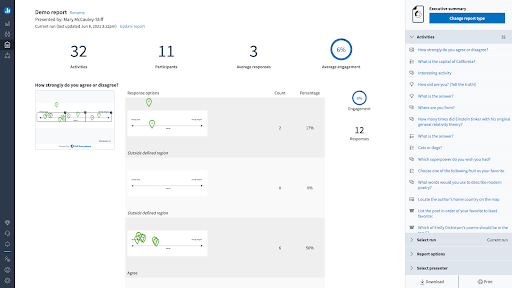
Executive summary report
At Poll Everywhere, we conduct a live session to share the anonymous results with the entire organization. Here, we use Q&A polls to gather live employee feedback about the results.
This approach helps us get an in-depth insight into what our employees would like to improve—which directs our efforts for the next six months. By deploying these surveys bi-annually, we have enough to act on the feedback and gauge its ground impact.
Channels: MS PowerPoint, Slack, Webex, Microsoft Teams, Google Slides, Keynote
Connecteam
Connecteam is a workforce management application that allows managers and leaders to manage their employees. It offers features for various purposes like training and onboarding, documentation, regular evaluations, event booking, and communication.
Their Quizzes feature allows you to quiz employees on company workflows and compliance requirements—and even send pulse surveys.
Channels: Connecteam has its own quiz application.
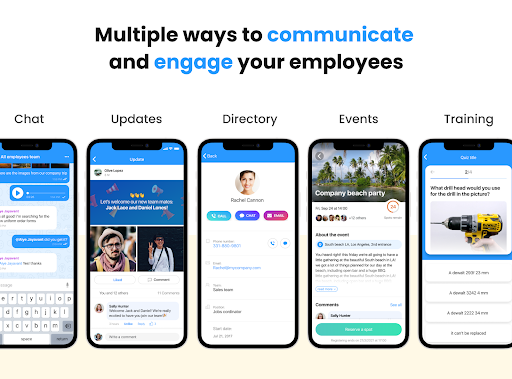
Culture Amp
Culture Amp is a popular employee experience platform that helps organizations improve
engagement, performance, and retention. It has multiple survey templates for measuring engagement, onboarding experience, exit experience, team effectiveness, and more.
Channels: Culture Amp has its own application, but respondents can be invited via email or Slack. You can also send a link manually.
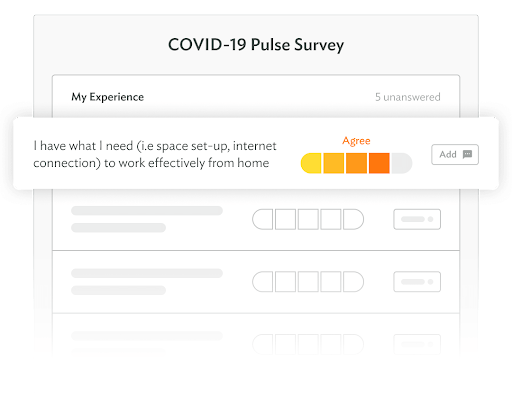
Google Forms
Google Forms is a free form builder tool offered as part of the Google Suite. You can create a survey from scratch, and it’s perfect for deploying surveys in smaller teams.
The benefit is that you can collect feedback using a Likert scale or add a paragraph option for open-ended engagement questions. The drawback is that you have to design the survey from scratch and analyze the data manually.
Channels: Email invitations only. Otherwise, a Google Form needs to be sent manually through messaging or other applications.
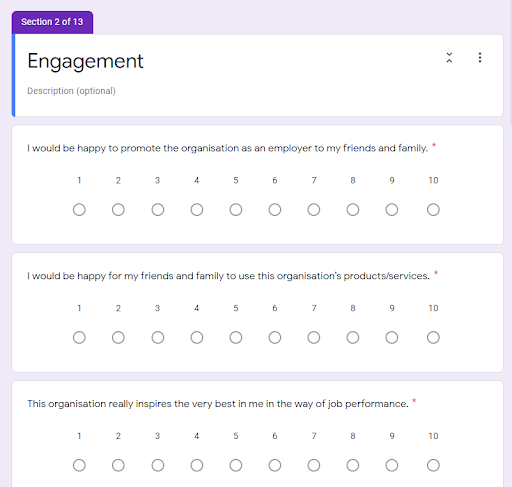
Best practices for conducting employee engagement surveys
Ensure that the survey is focused on a single goal
One issue that many organizations run into is that their surveys lack a single focus. This leads to answers that don’t provide any insight or actionable recommendations for improvement.
Sylwia Śmietanko, an HR Specialist and Recruiter at Passport Photo Online says, “The best tip I can give is that sometimes you have to metaphorically poke someone to get the truth out. You should ask very specific questions and give the surveyed enough space and time to answer. Employees will immediately notice if you’ve just copy-pasted generic questions. Asking the right questions will get you the best answers.”
The key to success with employee engagement surveys is to focus on one specific goal and make the questions in the survey directly related to that goal. This increases the quality of the feedback too.
Use short surveys to encourage completion
Your goal is to obtain the information you want, but you’ll also want to consider how you will use that information.
Too many questions may make the process more like a test than a survey, and your employees will be less inclined to complete it. Doing so leads to a low response rate.
A SurveyMonkey report found that a 10-question survey has a completion rate of 89%, while a 40-question survey has a completion rate of 79%. So, keep it short and focused.
Keep the language simple and clear
A survey with unclear questions and confusing statements can result in skewed and incomplete results.
To make the most of your survey, you must keep the language simple and clear. This allows respondents to answer without reading too much into the question. The best surveys are written with a clear purpose that doesn’t confuse or intimidate the participants.
When creating your survey, it’s best to use words like “productivity,” “motivation,” and “satisfaction” because these are common terms that people use every day.
Use the sandwich approach for survey design
Start with questions that are very simple to answer. Such questions will boost the morale of your employees and make them feel that you care about them and their opinions.
Then, you can put difficult, thought-provoking questions in the middle. This gives employees time to think and answer more critically.
Your last question should end on a positive note, as employees appreciate being heard. Here, you can include open-ended questions encouraging them to give qualitative feedback.
Avoid asking double-barreled questions
When finalizing employee engagement survey questions, you should avoid double-barreled questions. This type of question combines two distinct, potentially unrelated questions in one.
The problem with double-barreled questions is that the reader might need clarification. Questions should be focused on one central point so that the results are simple to interpret and make sense.
Example:
Ask: Do you feel like your team members communicate well?
(or)
Do you feel like your team members get the job done?
Not: Do you feel like your team members communicate well and get the job done?
Limit the number of open-ended questions
Open-ended or qualitative questions are excellent when you want to give employees a space to voice their concerns. However, if you ask too many open-ended questions, your survey’s data quality will suffer because the answers will be wordy and inconsistent.
These questions also increase the time to survey completion—which is not ideal when employees are already pressed for time. One or two open-ended questions will suffice.
Ensure that the survey is anonymous and confidential
These surveys need to be anonymous. Anonymity helps employees be more candid about their opinions and increases their confidence in the results.
Andrea Meyer says, “Ensure the surveys are anonymous, then relay that message to employees. If leaders are set on improving their company, they need to hear the good, bad and ugly. The only way to do so is when employee engagement surveys are anonymous.”
Many people are concerned about the fact that there might be consequences for voicing their actual opinions. It’s best to implement anonymous surveys and focus on what the results are—not who said them.
Make the most of your next survey with Poll Everywhere
Using an employee engagement survey is a smart way to gauge if your employees are happy and how you treat them.
Keeping an eye on your employee engagement survey scores and score trends is much needed as it improves engagement within your workforce and creates a healthier workplace. As engaged employees are key to the success of a business, 80% of CEOs are looking forward to employing tools to drive loyalty and engagement in their workplace.
Using anonymous tools that encourage transparent feedback makes your employees feel seen and heard, increasing their motivation to contribute actively. This can save you time and money in the long run as it will help you identify issues before they become real problems.
If you’re looking for an employee engagement survey tool to create engaging surveys and feedback sessions, sign up for Poll Everywhere today.
